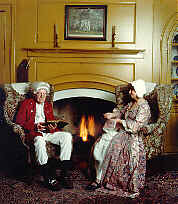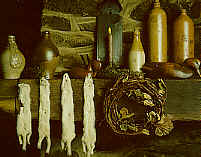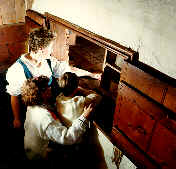Reverend Alexander Dobbin
and
The Historic Dobbin House
"Four Score and Seven Years" before President Lincoln delivered his immortal Gettysburg
Address (1863-87=1776), Gettysburg's oldest and most historic building, the Dobbin House,
was built. Just imagine the residents of the then eighty-seven year old house who probably sat
on the balcony to watch as Lincoln delivered his speech on a bluff a few hundred yards away at
the National Cemetery!
 Reverend Alexander Dobbin, who built the Dobbin House, was an
early frontier pioneer who helped settle and civilize the area. Born in
Ireland in 1742, he grew to be a man of keen foresight, a person highly
respected by his peers, an educator of men of stature, a Minister and a
rugged individual who played a major role in the founding of
Gettysburg. After studying the classics in Ireland, Dobbin and his bride,
Isabella Gamble, set sail for a new life in the New World. Shortly after
his arrival in America, he became pastor of the Rock Creek
Presbyterian Church, located one mile north of what is now Gettysburg.
Reverend Alexander Dobbin, who built the Dobbin House, was an
early frontier pioneer who helped settle and civilize the area. Born in
Ireland in 1742, he grew to be a man of keen foresight, a person highly
respected by his peers, an educator of men of stature, a Minister and a
rugged individual who played a major role in the founding of
Gettysburg. After studying the classics in Ireland, Dobbin and his bride,
Isabella Gamble, set sail for a new life in the New World. Shortly after
his arrival in America, he became pastor of the Rock Creek
Presbyterian Church, located one mile north of what is now Gettysburg.
In 1774, the Dobbin purchased 300 acres of land in and around what is now the town of
Gettysburg and commenced construction of a farm and the Dobbin House, for use as their
dwelling and as a Classical School, today's equivalent of a combined theological seminary
and liberal arts college. Dobbin's school was the first of its kind in America west of the
Susquehanna River, an academy which enjoyed an excellent reputation for educating many
professional men of renown.
 Rev. Dobbin needed a large house for his school and family, for his
Irish wife had borne him ten children before her early death. He
remarried to the widow, Mary Agnew, who already had nine
children of her own!
Rev. Dobbin needed a large house for his school and family, for his
Irish wife had borne him ten children before her early death. He
remarried to the widow, Mary Agnew, who already had nine
children of her own!
Rev. Dobbin, a short, stout, smiling gentleman who wore a white
wig, became a highly respected community leader, as well as
minister and educator. He worked diligently to establish in 1800 an
autonomous Adams County, which originally was a part of neighboring York County.
Thereafter, he was one of two appointed commissioners to chose Gettysburg as the new county
seat.
 In the mid-1800's, a secret crawl space, featured in "National
Geographic", served as a "station" for hiding runaway slaves on their
perilous journey to freedom on the "Underground Railroad." After the
battle of Gettysburg ceased, and the armies had departed, it served as a
hospital for wounded soldiers of both the North and the South.
In the mid-1800's, a secret crawl space, featured in "National
Geographic", served as a "station" for hiding runaway slaves on their
perilous journey to freedom on the "Underground Railroad." After the
battle of Gettysburg ceased, and the armies had departed, it served as a
hospital for wounded soldiers of both the North and the South.
Today the historic house appears virtually the same as it did over 200
years ago. Its native stone walls, seven fireplaces, and hand carved
woodwork have been painstakingly restored to their original beauty and character, with interior
decor in the traditional eighteenth century manner. Many of the home's antique furnishings are
identical to those listed in the inventory of Rev. Dobbin's estate. The china and flatware exactly
 match fragments which were unearthed during the re-excavation of the cellar.
The servant's period-clothing is completely authentic right down to the tie on
pockets!
match fragments which were unearthed during the re-excavation of the cellar.
The servant's period-clothing is completely authentic right down to the tie on
pockets!
As a truly authentic colonial tavern, patrons of the Dobbin House may "eat,
drink and be merry". Our recipes have been published in "Bon Appetite" and
"Cuisine" magazines. Truly a visit is more than a superior culinary delight, it is
an enchanting journey back to the charming quaintness and lively spirit of Gettysburg's and
America's beginnings!

 National Register of Historic Places (U.S.A.)
National Register of Historic Places (U.S.A.)
Registered Historic Landmark (PA)
Mobil Guide 
Want more information: Email us
89 Steinwehr Avenue (Business Route 15 South)
Gettysburg, PA 17325
Phone: 717-334-2100 Fax: 717-334-6905
Back to Home Page
Copyright © 1996 - 2012 Dobbin House Inc. All rights reserved.
 Reverend Alexander Dobbin, who built the Dobbin House, was an
early frontier pioneer who helped settle and civilize the area. Born in
Ireland in 1742, he grew to be a man of keen foresight, a person highly
respected by his peers, an educator of men of stature, a Minister and a
rugged individual who played a major role in the founding of
Gettysburg. After studying the classics in Ireland, Dobbin and his bride,
Isabella Gamble, set sail for a new life in the New World. Shortly after
his arrival in America, he became pastor of the Rock Creek
Presbyterian Church, located one mile north of what is now Gettysburg.
Reverend Alexander Dobbin, who built the Dobbin House, was an
early frontier pioneer who helped settle and civilize the area. Born in
Ireland in 1742, he grew to be a man of keen foresight, a person highly
respected by his peers, an educator of men of stature, a Minister and a
rugged individual who played a major role in the founding of
Gettysburg. After studying the classics in Ireland, Dobbin and his bride,
Isabella Gamble, set sail for a new life in the New World. Shortly after
his arrival in America, he became pastor of the Rock Creek
Presbyterian Church, located one mile north of what is now Gettysburg. Rev. Dobbin needed a large house for his school and family, for his
Irish wife had borne him ten children before her early death. He
remarried to the widow, Mary Agnew, who already had nine
children of her own!
Rev. Dobbin needed a large house for his school and family, for his
Irish wife had borne him ten children before her early death. He
remarried to the widow, Mary Agnew, who already had nine
children of her own! In the mid-1800's, a secret crawl space, featured in "National
Geographic", served as a "station" for hiding runaway slaves on their
perilous journey to freedom on the "Underground Railroad." After the
battle of Gettysburg ceased, and the armies had departed, it served as a
hospital for wounded soldiers of both the North and the South.
In the mid-1800's, a secret crawl space, featured in "National
Geographic", served as a "station" for hiding runaway slaves on their
perilous journey to freedom on the "Underground Railroad." After the
battle of Gettysburg ceased, and the armies had departed, it served as a
hospital for wounded soldiers of both the North and the South. 
 National Register of Historic Places (U.S.A.)
National Register of Historic Places (U.S.A.)